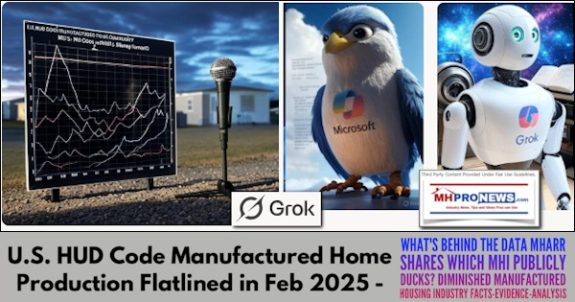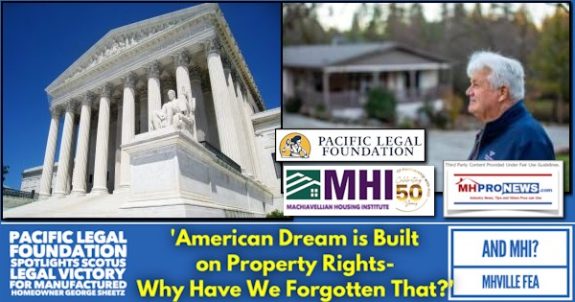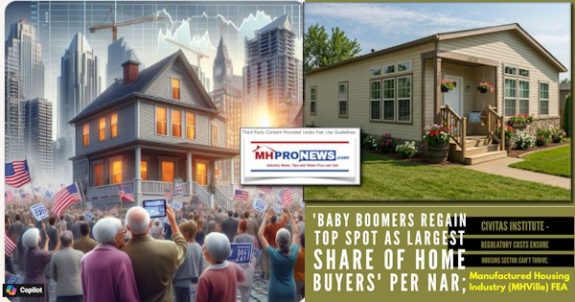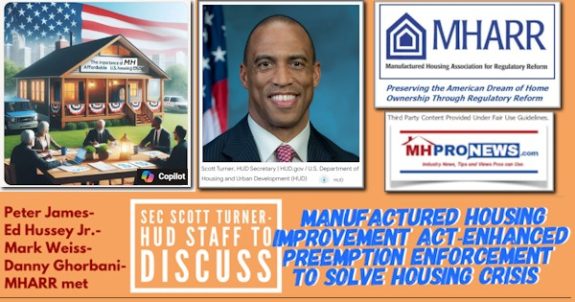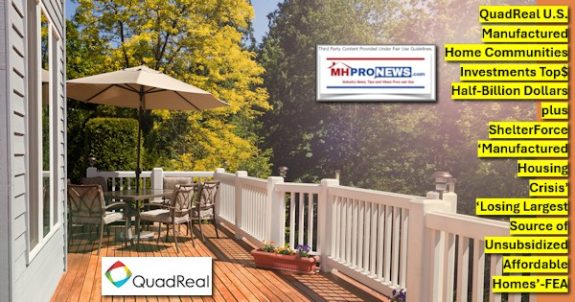MHI News
MHI Achieves Victory in Key CFPB Appraisal Rulemaking
On July 10th, the Consumer Financial Protection Bureau (CFPB), in cooperation with five other federal agencies, issued joint proposed regulations providing exemptions from appraisal requirements for certain higher-priced mortgage loans (HPMLs).
The appraisal requirements for higher-priced mortgages were imposed by the Dodd-Frank Act. In general, mortgage loans are considered to be higher-priced if they are secured by a consumer’s home and have an APR of more than 1.5 percentage points over the average prime offer rate (APOR). This includes manufactured housing loans.
The proposed rules released by the CFPB exempt from the appraisal requirements all transactions secured by existing manufactured homes and not land. This proposed rule is follow-up guidance from a final rule issued in January that exempted all loan transactions secured by new manufactured homes (with or without land) and all loan transactions involving mobile (non-HUD code) homes (with or without land).
The exemption for personal property transactions on manufactured homes coupled with the exemption for personal and real property transactions on new manufactured homes and mobile homes represents a significant victory for MHI and the manufactured housing industry and its consumers.
In addition to the exemption for loans on existing manufactured homes, the proposed appraisal requirement rule also exempts loans of $25,000 or less and certain types of “streamlined” refinance mortgage loans. From previous rules, Qualified Mortgages (QMs) are also exempt from the appraisal requirement.
Without this key exemption, creditors providing non-QM loans for the purchase of manufactured homes would have been required to perform a complete Uniform Standards of Professional Appraisal Practices (USPAP)-compliant appraisal, which includes an interior inspection, on the home being financed. Such a requirement represented a significant cost burden for consumers, an unnecessary burden on lenders, and is contrary to existing business practices.
Over the course of the past three years, MHI staff with members of the Dodd-Frank Taskforce — chaired by Tim Williams, CEO, 21st Mortgage —worked closely with representatives of the six federal agencies that comprise the joint working group charged with drafting the appraisal requirements for HPMLs, which includes the CFPB, Federal Reserve Board, Federal Deposit Insurance Corporation (FDIC), Federal Housing Finance Agencies (FHFA), National Credit Union Administration (NCUA) and Office of the Comptroller of the Currency (OCC).
The CFPB (and other agencies) are seeking comments to the proposed rule. Comments are due September 9, 2013 with appraisal guidelines to become effective January 2014. To view the proposed rule, click here.
Housing Finance Reform Bill to Contain MHI-Supported Regulatory Relief Provisions; Measure to Include H.R. 1779 Reforms
On July 11th, House Financial Services Committee Chairman Jeb Hensarling (R-TX) unveiled the Protecting American Taxpayers and Homeowners (PATH) Act (currently unnumbered) that would wind down Fannie Mae and Freddie Mac; reform the Federal Housing Administration (FHA); establish a new entity—a securitization outlet— that would be charged with packaging and selling mortgages to investors without providing a government-backed guarantee; and make reforms to the Dodd-Frank Act.
The legislation, which currently exists in draft form, is expected to be formally introduced the week of July 15th. The Financial Services Committee may mark up the legislation before the month-long August recess. The House measure follows housing finance reform legislation (S. 1217) introduced in the Senate last-month by Sens. Mark Warner (D-VA) and Bob Corker (R-TN).
The House bill would eliminate Fannie Mae and Freddie Mac over a five year period and establish a new entity in their place that would package and sell loans to investors—no government-backed guarantee would be provided. The measure is similar to the Senate plan. However, the Senate version does envision a government backstop to guard against catastrophic losses.
The new entity would serve as an outlet that would develop uniform underwriting criteria and utilize a securitization platform already developed by the Federal Housing Finance Agency for a new “Qualified Security.” Lenders would utilize the platform to package mortgages into mortgage securities for sale to investors.
While detailed bill language has not yet been revealed, the section of the measure amending the Dodd-Frank Act is expected to include the provisions of the Preserving Access to Manufactured Act (H.R. 1779). Specifically, the PATH Act would:
• Delete in its entirety Section 1431 of the Dodd-Frank Act, which revised the HOEPA High-Cost Mortgage triggers to cover purchase money loans, including manufactured home loans;
• Clarify that manufactured home loan retailers and their sales staff are not considered loan originators unless they receive compensation from a lender, creditor, mortgage broker, etc.
Inclusion of key manufactured housing relief provisions in the PATH Act is a significant step forward in providing the manufactured housing industry and its consumers with relief from provisions of the Dodd-Frank Act that would reduce the credit available to purchase manufactured housing.
According to initial information, all loans considered Qualified Mortgages (QMs) as well as non-QM of any size would be eligible for securitization through the new entity, which should include manufactured home loans secured by personal property.
The legislation would prohibit discriminatory fees based on the size, composition, business line or loan volume of an originator. The entity would have to maintain open access for all loan originators, aggregators, issuers and investors.
Those mortgages that are securitized through the new platform/entity would receive relief from certain Dodd-Frank requirements and additional relief would be provided for those lenders that elect to hold mortgages they originate in their portfolios and bear the credit risk of the loan.
A section-by-section summary of the reforms outlined in the legislation is provided below. Click here to view the bill. For additional summary information, click here. MHI will provide additional details and information as it becomes available.
I. GSE Reform
• Fannie Mae and Freddie Mac would be stripped of their government charters, the companies would be liquidated, and the portfolios and operations would be wound down over about a five-year period.
• Fannie Mae and Freddie Mac would continue to send all their profits to the Treasury Department, but the bill would not direct any proceeds to the companies’ current shareholders.
• The loan limits Fannie Mae and Freddie Mac can guarantee would be reduced over a five-year period by $20,000 annually to $525,500.
• Fannie Mae and Freddie Mac would be forbidden from financing loans outside of the CFPB’s qualified mortgage standards or in areas where local governments adopt plans to seize loans through eminent domain.
• Fannie Mae and Freddie Mac’s affordable housing goals and the affordable housing trust fund would be abolished, this would include the existing Duty-to-Serve requirement.
II. FHA Reform
• FHA would be spun off as a separate agency outside of the Department of Housing and Urban Development.
• FHA would be required to hold a four percent capital ratio on its emergency insurance fund, compared with two percent today.
• Over a transition period, the FHA would only be allowed to insure mortgages for first-time borrowers and those with low and median incomes, and it would be barred from insuring any mortgages in areas where eminent domain policies are adopted.
• The bill would reduce the loan limit FHA can insure to $625,500 from $729,750 today.
• Borrowers would be required to put at least five percent down on FHA insured loans, up from the 3.5 percent required today.
• FHA would be required to share some of its risk with private investors and the amount of the loan the agency covers would be reduced by 10 percent each year over five years until it insures roughly half of the risk of mortgages, as opposed to the entire loan today.
• FHA lenders would be required to repurchase loans if they become more than two months delinquent in the first two years, and borrowers who default would be barred from FHA financing for seven years.
III. Market Reforms
• The Federal Housing Finance Agency would regulate a new market utility that would own a securitization platform to be completed in two years that would allow smaller banks to finance their mortgages.
• The utility would not originate, service or guarantee any loans, but would set up a new “Qualified Security” that sets new underwriting standards for the loans. Loans that meet the standards would be exempt from some Dodd-Frank mortgage rules.
• Any users of the platform would agree to new guidelines regarding repurchases of faulty loans from investors in the bonds the utility issues.
• A new framework would establish rules for how banks can issue covered bonds as an alternative to securitizing loans or holding them on their books as a funding source.
• Establishes a two-year delay for the Basel III capital rules, forcing regulators to study the impact of the standards, and prohibits agencies from forcing banks to hold more capital against some mortgage bonds.
• Repeals the risk-retention rule (i.e., Qualified Residential Mortgage/QRM) under Dodd-Frank that forces lenders to hold some of the risk on the mortgages sold to private investors.
• Gives lenders until January 2015 to implement some Dodd-Frank mortgage rules.
The bill has already received criticism from some groups arguing that the measure could potentially eliminate the availability of affordable mortgage products. It is unclear if the measure will be opposed by the large national housing and mortgage finance organizations.
Despite the inclusion of these key manufactured housing-related provisions, assistance is still needed from those throughout the manufactured housing industry to continue gathering co-sponsors to H.R. 1779 (see related article for more information).
Dodd-Frank, CFPB and Financial Services Updates
Support Continues to Build for Manufactured Housing Relief Legislation
To date, nearly 40 U.S. Representatives have signed on as co-sponsors to H.R. 1779 and support for the measure continues to grow at a steady pace. For detailed information on the bill and to access the MHI action alert, visit www.manufacturedhousing.org. To view the current list of co-sponsors, click here.
MHI thanks industry members and its national network of state associations for the dedicated assistance and help in gathering co-sponsors. With key recent victories in rules modifications coming from the CFPB on manufactured housing appraisal guidelines and loan originator compensation guidelines for manufactured home retailers and salespersons, progress is being made. This is a result of the broad bipartisan support being demonstrated for H.R. 1779.
However, now is not the time to let up on our efforts! Please pass on any contact you may have had with your U.S. Representative. If you have questions or need additional assistance, contact MHI Vice President of Government Affairs Jason Boehlert at (703) 558-0660 orjboehlert@mfghome.org.
House Appropriators Seek to Rework CFPB Funding Model
The FY2014 Financial Services and General Government Appropriations bill includes a provision to change the funding source for the CFPB from the Federal Reserve to the Congressional appropriations process, beginning fiscal year 2015. Currently, funding is provided by mandatory spending and is not subject to annual congressional review. Republican lawmakers have consistently called for greater opportunity to subject the CFPB to Congressional oversight; subjecting the agency’s funding to the annual appropriations process could potentially require the CFPB to be more responsive to Congressional complaints. The bill is expected to be marked up by the full committee prior to the August recess.
CFPB Releases Mortgage Rules Readiness Guide
On July 8th, the CFPB released a Dodd-Frank Mortgage Rules Readiness Guide to help financial institutions come into and maintain compliance with new mortgage rules finalized by the agency in January 2013. According to the CFPB, the guide’s purpose is to:
• Assist regulated entities achieve compliance with the mortgage rules;
• Highlight key issue areas that may be closely examined during a review; and
• Focus the industry and examiners on key elements of a compliance management system that may warrant review, modification, or other enhancement.
To access the guide, click here.
CFPB Releases Final Rural and Underserved Counties List for 2014
On July 9th, the CFPB released a final list of “rural” or “underserved” counties for use in 2014. The CFPB has indicated that creditors may rely on this list as a safe harbor to determine whether a county is “rural” or “underserved” for loans made during a given calendar year. The following CFPB rules have provisions that relate to mortgage loans made by creditors operating predominately in rural or underserved counties:
• The final ability-to-repay rule allows certain small creditors that operate predominately in rural or underserved counties to make balloon payment qualified mortgages.
• The final HOEPA rule includes an exemption from the balloon payment prohibition on high-cost mortgages for creditors operating predominately in “rural” or “underserved” counties.
• The final mortgage escrow account rule exempts certain creditors operating primarily in rural or underserved counties from the requirement to establish mandatory escrow accounts on higher-priced mortgage loans (HPMLs). The CFPB has proposed to broaden this exemption to cover a small creditor that extended more than 50 percent of its total covered first-lien loans in rural or underserved counties in any of the three preceding calendar years (instead of in the preceding calendar year).
For more information, click here to visit the CFPB website.
CFPB Issues Rules for Supervising Nonbanks Engaged in Risky Conduct
On July 2nd, the CFPB issued final rules establishing procedures for supervising nonbanks engaged in conduct that poses risk to consumers. The Dodd-Frank Act authorized the agency to supervise any nonbank it has reasonable cause to determine “is engaging, or has engaged, in conduct that poses risks to consumers with regard to the offering or provision of consumer financial products or services.”
The CFPB’s authority covers nonbank providers of consumer financial products or services and extends to a nonbank’s affiliate service providers. This is in addition to the CFPB’s authority to supervise a nonbank that is any of the following:
• Regardless of its size, a provider of residential mortgage loans or certain related services, payday loans, or private education loans;
• A provider considered to be “a larger participant of a market for other consumer financial products or services”; or
• Regardless of its size, a service provider to another entity subject to CFPB supervision.
For more information, click here.
5,659 New HUD-Code Homes Shipped in May 2013
In May 2013, 5,659 new manufactured homes were shipped, up 8.9 percent from May 2012. Increases were across the board with shipments of both single-section and multi-section homes up compared with the same month last year. Total floors shipped in May 2013 were 8,733, an increase of 8.7 percent compared with May 2012.
In comparison with 2012, 2013 shipments started with an increase in January followed by a decline in the months of February and March. The upward trend returned in April and May with increases in shipments. For the first five months of this year, shipments totaled 23,791 homes compared with 22,627 homes in 2012, a net increase of 5.1 percent.
The seasonally adjusted annual rate (SAAR) of shipments was 61,536 in May 2013, up 1.3 percent from the adjusted rate of 60,767 in April 2013. The SAAR corrects for normal seasonal variations and projects annual shipments based on the current monthly total.
The number of plants reporting production in May 2013 was 122 and the number of active corporations was 46, both unchanged from the prior month.






















